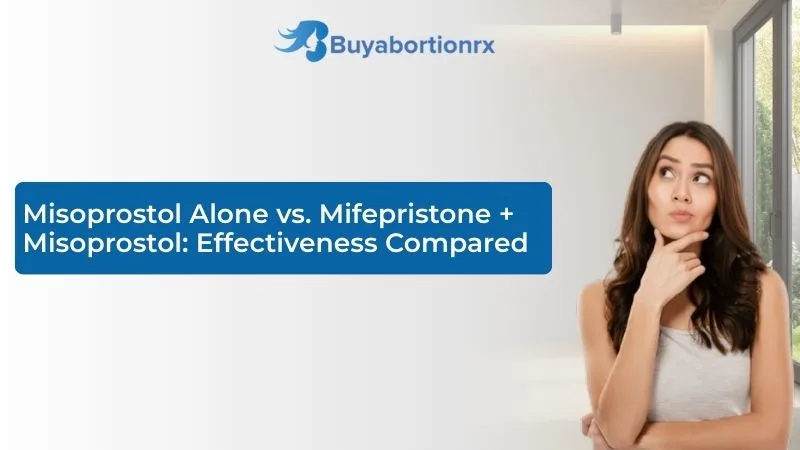Not just in the USA, where reproductive health rights are quite liberal, but abortion pills are the most common means for early pregnancy termination worldwide. The method is self-initiated at home by most women due to privacy and lower expenses, in contrast to an in-clinic procedure. Two main regimens are the Mifepristone and Misoprostol combination and Misoprostol-only. Since the medical abortion success rate is high in the initial 10 to 12 weeks of pregnancy, many choose it to manage an unintended pregnancy. The purpose behind the blog is to make people understand abortion pill effectiveness comparison, safety, availability, and what studies say, to help them make an informed choice.
What Are Abortion Pills?
The abortion pill, Mifepristone, stops a pregnancy’s progress by blocking the hormone progesterone. It does not allow the endometrial lining to stay attached to the uterine wall. It breaks down these tissues and separates the pregnancy in the womb. Whereas, Misoprostol expands the cervix and induces uterine contractions to expel the pregnancy contents. Heavy vaginal bleeding and abdominal cramps with pain follow. While Misoprostol alone effectiveness is undisputed, many choose the Mifepristone and Misoprostol combination due to the higher success rate. However, several nations do not provide the Mifepristone pill, which makes Misoprostol the remaining option for pregnancy termination.
Abortion Pill Effectiveness Comparison
Here is a brief comparison of the Mifepristone and Misoprostol combination process vs. the Misoprostol-only procedure:
Mifepristone + Misoprostol (Combination)
The Mifepristone plus Misoprostol abortion pill effectiveness comparison is 95% to 99% for a pregnancy up to 10 to 12 weeks. One of the benefits of this process is a lower chance of needing a surgical termination during follow-up. The process takes a shorter time compared to using only Misoprostol (also needs fewer doses of this pill). First, you take 200mg of Mifepristone orally with water. After a day or two, take Misoprostol 200 mcg (4 pills) vaginally or buccally (rest the pills for half an hour in the mouth before consumption).
Misoprostol Alone
When it comes to Misoprostol alone effectiveness in ending a pregnancy, it is 80% to 90% depending on the dosage and pregnancy weeks. The process entails multiple doses of this abortion pill at 24 to 48 hours apart. Sometimes, additional follow-up care is required in case of an incomplete abortion. This is the reason why the Mifepristone and Misoprostol combination scores a higher point in the medical abortion success rate ratio. You take Misoprostol pills 4 at once at a gap of 4 to 6 hours each, buccally (pills in the cheek pouches). For a pregnancy within 5 weeks, 8 pills are needed. However, 10 to 12 pills are required for a pregnancy over 6 weeks but within 12 weeks. Thus, in the abortion pill effectiveness comparison, the combination method is more feasible in every way.
Safety and Side Effects of Medical Abortion
Let us delve into the details of what to expect from a medication pregnancy termination, including the side effects and differences in experiences.
1. Common Side Effects (Both Methods)
When Mifepristone disrupts the endometrium, you may not experience noticeable changes in the body. However, after taking Misoprostol (4 to 8 pills if used with Mifepristone), 24 to 48 hours later, you may begin with abdominal cramps and pain in a couple of hours or more. After which, heavy vaginal bleeding starts to disperse the pregnancy from the womb. You may encounter other side effects due to hormonal changes such as nausea, diarrhea, stomach upset, tiredness, headache, mild fever, etc. These are temporary and manageable at home. Over-the-counter pain relief medications, antiemetic pills for nausea and vomiting, hot compresses for the cramps, and taking enough rest are some measures to combat these episodes.
2. Differences in Experiences
If you use the Mifepristone and Misoprostol combination, the bleeding and cramping are usually shorter. This is because Mifepristone already does a lot of abortion tasks by dislodging the pregnancy tissues in the womb, making it easier for Misoprostol to dispel the conception products. However, Misoprostol alone effectiveness is spread out as this pill has to do everything by itself to remove the pregnancy. The procedure (8 to 12 Misoprostol pills) may lead to more bleeding and take a longer time for termination.
Availability and Access of Abortion Pills
The WHO recognizes the Mifepristone and Misoprostol combination and Misoprostol-only regimens as safe when used correctly. Given that the medical abortion success rate is better with both abortion pills included, women usually prefer that, in contrast to taking only Misoprostol pills. However, Misoprostol is easier to obtain as it is also used to treat gastric ulcers. Moreover, many countries have strict regulations against Mifepristone availability due to the need for a prescription. In such cases, one has to depend on Misoprostol alone effectiveness for pregnancy termination.
Which Option is a Better Medical Abortion Method?
It is important to follow the correct dosage no matter which method you choose for pregnancy termination. Both regimens are safe and effective. However, the Mifepristone and Misoprostol combination is the first choice as it has several benefits. It ensures faster recovery and lower intensity of side effects. The Misoprostol abortion pill effectiveness comparison shows a longer time for the procedure, more bleeding, and side effects. Also, Misoprostol-alone use becomes the only option where access to Mifepristone is limited.

